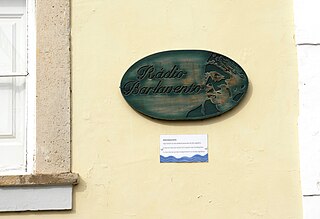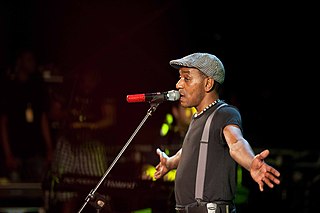
Mindelo is a port city in the northern part of the island of São Vicente in Cape Verde. Mindelo is also the seat of the parish of Nossa Senhora da Luz, and the municipality of São Vicente. The city is home to 93% of the entire island's population. Mindelo is known for its colourful and animated carnival celebrations, with roots in Portuguese traditions.
Manuel d' Novas was a Cape Verdean poet and composer.

Monte Cara is a mountain in western part of the island of São Vicente, Cape Verde. Its elevation is 490 m. It resembles a human face looking at the sky, hence its name, which means "face mountain". It is a landmark of the city of Mindelo, from which it can be seen across Porto Grande Bay.

São Pedro is a village in the southwestern part of the island of Sao Vicente, Cape Verde. It is situated on the south coast, approximately 10 km southwest of the island capital Mindelo. In 2010 its population was 991. Cesária Évora Airport, the island's international airport is directly north of São Pedro. It was mentioned as a small port as "P. St. Pedro" in the 1747 map by Jacques-Nicolas Bellin. The lighthouse Farol de D. Amélia sits on the Ponta Machado, 3 km west of the village.

Cesária Évora Airport is Cape Verde's fourth-busiest airport, located on the island of São Vicente, nearly 5 kilometres (3.1 mi) from the centre of Mindelo. It is located in the valley area in the west of the island and is north of the village of São Pedro. Its runway is 1,975 metres (6,480 ft) long and its width is 45 metres (148 ft).

Ilhéu dos Pássaros is an uninhabited rocky islet in the bay of Mindelo, São Vicente Island, Cape Verde. It lies about 1.3 km (0.8 mi) west of the headland Ponta João Ribeiro, and 3.5 km (2.2 mi) northwest of Mindelo city centre. It lies between the Porto Grande Bay and the Canal de São Vicente, the channel of the Atlantic Ocean that separates the islands of São Vicente and Santo Antão. There is a lighthouse on the islet.

Rádio Barlavento was a radio station in Cape Verde which broadcast in the Portuguese language from 1955 until 1974. It was a shortwave (CR4AC) station broadcasting on 3930 kHz. From 1947 until 1955 it was called Rádio Clube do Mindelo. In 1974 it was seized by members of the Partido Africano da Independência de Guiné-Bissau e Cabo Verde - PAIGC, who sought to "get the station out of hands of those who aligned with colonial power." After this the station became Radio Voz de Sao Vicente. The station served the entire Barlavento island group including Santo Antão, São Vicente, São Nicolau, Sal and Boa Vista. The station was located in a building near downtown Mindelo, which is now the Centro Nacional de Artesanato e Design, and broadcast Cape Verdean traditional music, local programs, and Portuguese and some international programming. Rádio Voz de São Vicente later became an affiliate of RCV, Mindelo's own station would have another separate one and would be named Ràdio Nova.

Ponta João d'Évora is a headland on the north coast of the island of São Vicente. It is located about 5 km northeast of Mindelo city centre and 3 km northwest of Salamansa.

Cesária Évora, GCIH was a Cape Verdean vocalist and recording artist. Nicknamed the "Barefoot Diva" for performing without shoes, she was also known as the "Queen of Morna".

Avenida Marginal is an important street in Mindelo, São Vicente island, Cape Verde. It runs along the coast of the Porto Grande Bay, connecting the city centre with the northwestern outskirts (Matiota). Its southern end is the intersection with Rua Libertadores de África and Rua da Praia, that continues south along the coast. Avenida Marginal runs along the port of Mindelo, below Fortim d'El-Rei and along Praia da Laginha in Matiota.

Fantcha is a Cape Verdean singer.

Tito Paris, is a singer and musician. He has a long career behind him. Tito Paris moved as a young man, aged 19, to Portugal. Lisbon continues to be his hometown even if he still goes back to his islands.
Orlanda Amarílis Lopes Rodrigues Fernandes Ferreira, known as Orlanda Amarílis was a Cape Verdean writer. She is considered to be a noteworthy writer of fiction whose main literary themes include perspectives on women’s writing, with depictions of various aspects of the lives of Cape Verdean women as well as depictions of the Cape Verdean diaspora. She has been described as "indisputably one of Cape Verde’s most talented writers".
Cais-do-Sodré té Salamansa is the first short story book published in 1974 by Cape Verdean writer Orlanda Amarílis. This collection consists of seven short stories in which the day-to-day lives of Cape Verdean emigrants are portrayed. Unlike some earlier romanticized accounts of the diaspora written by other Cape Verdean writers, Amarilis’ book projects a realistic and not-so-romanticized view of the Cape Verdean diaspora, and it is mainly concerned with the diaspora in Portugal.
Hermínia da Cruz Fortes, better known as Hermínia d'Antónia de Sal, was a Cape Verdean singer.

Djô d'Eloy born Adolfo de Jon Xalino was a Cape Verdean singer, composer and guitarist. He belonged to the Xalino family of singers. His greatest singles included "Arriola" and "Grandeza", both appeared in the album Nos Festa in 1981. he was of the Xalino family. His most famous singles were "Reanima" and "Celina". Alongside Bana, he was the founder of the nation's first music festival, the Baía das Gatas Music Festival.

Liceu Velho is a building in the eastern part of the city centre of Mindelo, Cape Verde. It is situated on Praça Dr. Duarte Silva, between Avenida Fernando Ferreira Fortes and Rua Franz Fanon, east of the Palácio do Povo. Since 2008, it houses the art school M_EIA, officially Instituto Universitário de Arte, Tecnologia e Cultura. It is also one of the locations of the School of Business and Governance (ENG) of the University of Cape Verde.
The Culture of the Island of São Vicente, Cape Verde is the second richest in the nation, with a range of customs and practices common in the islands,



















